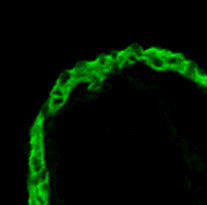ARG10147
anti-Cardiac Troponin T antibody [1C11]
anti-Cardiac Troponin T antibody [1C11] for ELISA,ICC/IF,Immunohistochemistry (PFA perfusion fixed frozen sections),IHC-Frozen sections,IHC-Formalin-fixed paraffin-embedded sections,Immunoprecipitation and Human,Mouse,Rat,Dog
Cell Biology and Cellular Response antibody; Controls and Markers antibody; Developmental Biology antibody; Signaling Transduction antibody
Overview
| Product Description | Mouse Monoclonal antibody [1C11] recognizes Cardiac Troponin T |
|---|---|
| Tested Reactivity | Hu, Ms, Rat, Dog |
| Tested Application | ELISA, ICC/IF, IHC-FoFr , IHC-Fr, IHC-P, IP |
| Specificity | No cross-reaction with skeletal TnT. |
| Host | Mouse |
| Clonality | Monoclonal |
| Clone | 1C11 |
| Isotype | IgG1 |
| Target Name | Cardiac Troponin T |
| Antigen Species | Human |
| Immunogen | free human cTnT |
| Conjugation | Un-conjugated |
| Alternate Names | RCM3; CMPD2; LVNC6; TnTC; TnTc; CMH2; cTnT; Cardiac muscle troponin T; CMD1D; Troponin T, cardiac muscle |
Application Instructions
| Application Suggestion |
|
||||||||||||||
|---|---|---|---|---|---|---|---|---|---|---|---|---|---|---|---|
| Application Note | IHC-P: Antigen Retrieval: Citrate buffer (pH 6.0) for 5 - 10 min. * The dilutions indicate recommended starting dilutions and the optimal dilutions or concentrations should be determined by the scientist. |
Properties
| Form | Liquid |
|---|---|
| Purification | Protein A affinity purified. |
| Buffer | PBS (pH 7.4) and 0.1% Sodium azide |
| Preservative | 0.1% Sodium azide |
| Concentration | 1.0-2.0 mg/ml |
| Storage Instruction | For continuous use, store undiluted antibody at 2-8°C for up to a week. For long-term storage, aliquot and store at -20°C or below. Storage in frost free freezers is not recommended. Avoid repeated freeze/thaw cycles. Suggest spin the vial prior to opening. The antibody solution should be gently mixed before use. |
| Note | For laboratory research only, not for drug, diagnostic or other use. |
Bioinformation
| Database Links | |
|---|---|
| Gene Symbol | TNNT2 |
| Gene Full Name | troponin T type 2 (cardiac) |
| Background | The protein encoded by this gene is the tropomyosin-binding subunit of the troponin complex, which is located on the thin filament of striated muscles and regulates muscle contraction in response to alterations in intracellular calcium ion concentration. Mutations in this gene have been associated with familial hypertrophic cardiomyopathy as well as with dilated cardiomyopathy. Transcripts for this gene undergo alternative splicing that results in many tissue-specific isoforms, however, the full-length nature of some of these variants has not yet been determined. [provided by RefSeq, Jul 2008] |
| Function | Troponin T is the tropomyosin-binding subunit of troponin, the thin filament regulatory complex which confers calcium-sensitivity to striated muscle actomyosin ATPase activity. [UniProt] |
| Research Area | Cell Biology and Cellular Response antibody; Controls and Markers antibody; Developmental Biology antibody; Signaling Transduction antibody |
| Calculated MW | 36 kDa |
| PTM | Phosphorylation at Thr-213 by PRKCA induces significant reduction in myofilament calcium sensitivity and actomyosin ATPase activity. |
Images (2) Click the Picture to Zoom In
-
ARG10147 anti-Cardiac Troponin T antibody [1C11] IHC-P image
Immunohistochemistry: Paraffin-embedded Mouse embryo (E9.75) section stained with ARG10147 anti-Cardiac Troponin T antibody [1C11] at 1:150 dilution. Antigen Retrieval: Citrate buffer (pH 6.0) for 5 - 10 min.
-
ARG10147 anti-Cardiac Troponin T antibody [1C11] IHC-Fr image
Immunohistochemistry: Frozen section of Human myocardial tissue stained with ARG10147 anti-Cardiac Troponin T antibody [1C11] at 1:300 dilution.
Clone References









